Caravane Tighmert: self-questioning
clarification: it should be specified that in this text there are personal opinions (the majority) and other collective ones, we, refer to a part of the team of Caravane Tighmert, in particular, Ahmed, M'barek, Mohamed and Bouchra.
the purpose of Caravane Tighmert
For 7 years I have asked myself a lot of questions about what we are organising in Tighmert, but more intensely after what happened between 2020 and 2021; the journey to Mauritania (Obûr); the decision to organise Caravane Ouadane; the exhibition À l’Épreuve du Tamis (which took place at Le 18 in Marrakech); the lockdown; the fire at the oasis (and the reaction Soutenir Tighmert); 2020 and 2021 Caravane Tighmert editions; my forced “exile” from Morocco because of the virus for more than a year...
Very varied and complex questions and reflections have arisen; the suitability of our proposals to artists; how to organise them; the relationship with the inhabitants (sedentary or nomadic); the compatibility with the desert; the collaboration with other cultural structures or programs (Le 18, Qanat, Sakhra, universities); the exchanges and links forged with artists who have passed through Tighmert... Some subjects have been dealt with in a personal way, others with friends or discussed during epilogues and through documents shared online. It is thanks to this constant questioning that we have evolved in our perception of how we should-could develop contemporary culture in Tighmert, with our means. However, all these discussions have reinforced some of our positions, but they also questioned the need and usefulness of such a strategy in the desert.
Is it really worth the effort to keep organising Caravane Tighmert? Have we been able to attract the attention of artists, not only to the artistic gathering but to the desert? If you look at the number of applicants (compared to calls for artists made in the rest of the country), one could argue that maybe we failed, but it is true that these data cannot be decisive. What would happen if we decided to quit? Honestly, artistically, nothing. Some artists would say it would be a shame but nothing more. For us, the organisers, we could dedicate our energy, time and money to other activities (or just doing nothing); personally I could visit more often my friends who live in Europe or in the valleys of river Drâa and river Ziz; I would have a second temporary window to do Qafila; I could explore the desert territories of Mauritania, Algeria, Iran...
However, if you consider aspects that are not directly related to art, the decision to quit would be much more difficult. We have been doing workshops for children with artists for 9 years (we started in 2013 with Warsha Sahara) and we have seen during these years the effects of cultural activities on the population, on condition of developing them continuously and for a long period of time.
The impacts of culture cannot be measured with administrative statistics
With Ahmed, we recently had a conversation about the impact of Caravane Tighmert on (part of) the population, especially on local team members (like Ghassan Kaaibich and Mohamed Zarragane), who take advantage of the artists to learn techniques, research methodologies and of course to know about their own culture, always through the prism of contemporary art.
But apart from Tighmert and his people, what do we bring to the Moroccan arts and culture scene? Should we, who are on the outskirts of remote areas, be thinking about this question? Especially since we do not have a curatorial ambition or a theoretical postulate to defend and taking into account that for my part, I do not belong to the world of contemporary art and I do not want to be part of it, even if that interests me. From the beginning, we knew we had to build our own "project" without copying the fashionable models encouraged by European and Arab institutions, simply because they cannot be applied to a place like Tighmert, to organise an annual event and, most of the editions, without public. I don't know what would have happened if we had ever been selected for the applications we applied to during these years (Institut Français, Ministère de la Culture et de la Jeunesse et des Sports, Fondation Kamel Lazaar, Fonds Roberto Cimetta, AFAC, Ambassade du Royaume des Pays-Bas, Fondation Anna Lindh, Province de Guelmim et Région Guelmim-Oued Noun). Would we have been forced to enter into a dynamic closer to the cultural industry or would we have been able to keep our identity? I do not know the answer, but if we have come this far with such a proposal, it is thanks to the ability to adapt to the constraints (or advantages) of being in the desert (for me it is the key to understanding how we act) and to have neither funding nor administrative supervision. However, the lack of money should not be a reason to validate positively or negatively our project, it is not because we are doing Caravane Tighmert without public funding that our project could have more value or that we could be more permissive with our errors and failures.
desert and art scene
Despite being an “unorganized” and “unprofessional” cultural structure and without institutional funding, could it be said that we belong to the Moroccan artistic scene? This brings me to other questions; Who makes up this scene, galleries, museums, media, artists, collectors, public institutions? Is there room for independent structures? Do those who promote creation have the same importance as those who promote the art market? I think we should differentiate between the creative scene, the promotional scene and the commercial scene, even if there has to be a close relationship between them (or not). But let's leave this debate so as not to deviate too much from the original subject (especially since I am neither Moroccan nor resident in Morocco and I will never be part of this scene) and return to the art scene in generic terms. How many years does it take for Caravane Tighmert to be included in this scene? Is it enough one year, five, ten ...? Or the measure of merit is established according to certain parameters such as the number of participants; the number of appearances or mentions in general and specialized media; the amount of academic research that mentions us; the number of invitations to give lectures or participate in debates...?
I cannot deny that sometimes I thought of the need to cross the ten years so that we can “deserve” a place on the contemporary scene, but I saw how the proximity to big cities like Rabat and Casablanca can talk about a single edition of an event, with much more enthusiasm and intensity than Caravane Tighmert after 7 editions. This was the case of Sakhra, which I co-organised with artists Abdeljalil Saouli and Gilles Aubry and that for the moment there has been only one edition, celebrated in Moulay Bouchta al-Khamar (Taounate) in March 2019. Being at the origin of both projects and seeing the impact so diverse, allows me to stay away from media publications and commentary in artistic circles when it comes to giving real value to any cultural proposition without paying attention to the reactions of third parties. However, I would like to clarify that Caravane Tighmert and Sakhra are of great interest to me and both events share the same questions, although some answers are diverse since the population, space and main research topics are different.
Ultimately, the question of belonging, or not, to the artistic scene should not prevent us from following our path, I am convinced that we cannot work with this objective, it will be a task for researchers and art historians to decide, in the future, whether what we do has a value or not.
I rather prefer to be consistent with my attitude towards everything I do, as an architect and as a cultural activist, an attitude that has permeated many creators, and that comes from Fernando Pessoa, who wrote that literature without thinking we are writing literature, a precept that Alejandro de la Sota (one of the main Spanish architects of the 20th century) practiced in his projects and that he passed on to a great friend, teacher and architect, Resti Bravo, who at the same time taught us, his students from the School of Architecture of Seville.
This attitude could help us resolve a few conflicts and decisions that come our way as we gain more visibility, whether through comments from artists who have come to Tighmert or through the echo created by our friends at LE 18 de Marrakech who try to make us known through its lectures (Qanat: past, present and futur of oases), its round tables (Retour de Tighmert), its exhibitions (À l’Épreuve du Tamis), its publications (Chergui 001 et Chergui 002) and the references they give of us to those who want to know what is happening culturally in Morocco. Obviously we can only show our gratitude for this effort and generosity but I ask myself a question, what is this recognition of our activities for? On the one hand, to have more applications and at some point to improve even more the level of participants, but that should not be our objective either because for us, it is important to base ourselves on Moroccan (and now on Mauritanian) artists (over foreigners with no relation to the desert) so that they develop their own culture, especially if their origins are in desert regions. Our participation at the 1_54 Contemporary African Art Fair in February 2020 (thanks to LE 18), more specifically to the Forum roundtable, Enacting Agencies, and at the exhibition À l’Épreuve du Tamis gave us the opportunity to make ourselves known to unimaginable levels; collectors, artists, art curators from all over the world were able to discover our activities, but I was also exposed to situations that made me think a lot during the lockdown. According to a friend, I was very arrogant during my speech at Mamounia hotel where I was invited to explain the relationship between contemporary art and society, from our experience at Tighmert. It is very likely that my attitude was arrogant, but it was my reaction to a fair and its buyers who are precisely very, very far from a sociaty like the Moroccan one, where I even felt I was being used, so that they can say, “Here we are, we have a social side in the fair and we give a voice to those who do not have the means to make themselves known”. Maybe I should have declined the invitation, as I had already done in 2018 when Voice Gallery wanted to include us in the Fair Forum program, but after meditating, I thought to myself that this time, our participation might help to understand the importance of what we do with the locals and team members in Tighmert. I also thought of the opportunity to introduce people to the oasis and the Hassaniya culture.
What worries me about visibility is the time we have to spend explaining the project to these artists and programmers whose interest is a consequence of this notoriety and not of our “artistic proposal”, as if they had no criteria to decide what is interesting and what is not, especially since I see how interest in the desert in terms of space of creation increases, but in a very superficial way (it's the same problem that cinéma has). Projects that some friends see as competition, or directly as plagiarism, but to which I pay no attention. This was the case with Kafila, the nomadic residence organised by the French Institut that when they saw the controversy on social networks over its resemblance to Project Qafila (even though I had written a text refuting the comparison), they tried to invite us, or rather integrate us into their project (Email subject: Kafila invites Qafila), with great insistence by email to exchange our ideas by phone, but without ever having had this call. Or one-week artistic residencies for discovering the Drâa valley where artists produce images with the desert as a simple backdrop.
a cultural project cannot be parachuted into a desert, it is necessary to give time to the organsers and to the participants, so that it can develop, define itself, which we have been trying since 2013 in Tighmert
As we saw in the epilogue of the last edition, we could describe Caravane Tighmert as a door that we open to artists and researchers so that they can intuit the complexity of the desert and the opportunities it offers to contemporary creation, on condition of crossing this door and dedicating time to study, to observe, to understand and not necessarily to produce (especially not immediately). We are aware that with the experiences we put the participants in, we can give a false image, that of also using the desert as a backdrop. Spending days and nights in the desert can seem like we are just camping, instead of trying to teach community behaviours and attitudes in extreme and dangerous territories, with “methodologies” acquired during Project Qafila.
We know that these images can harm our project by attracting tourists rather than artists interested in working on the desert. The trivialisation of the desert and the participation in the 1-54 Art Fair made me want to go "underground" in the sense of no longer communicating the event on social networks and only receiving artists who have had an acquaintance of Caravane Tighmert through word of mouth, avoiding artists who may be attracted to the published images of the desert by considering us a travel agency specialising in the desert and specific for artists, but without having a real interest in working on a project or research. To avoid this type of "audience", I thought to myself that maybe we should leave our website as a digital archive and to publish only the calls for candidates on the networks. It is something we need to think about and discuss with the team...
the southern shore of the Sahara
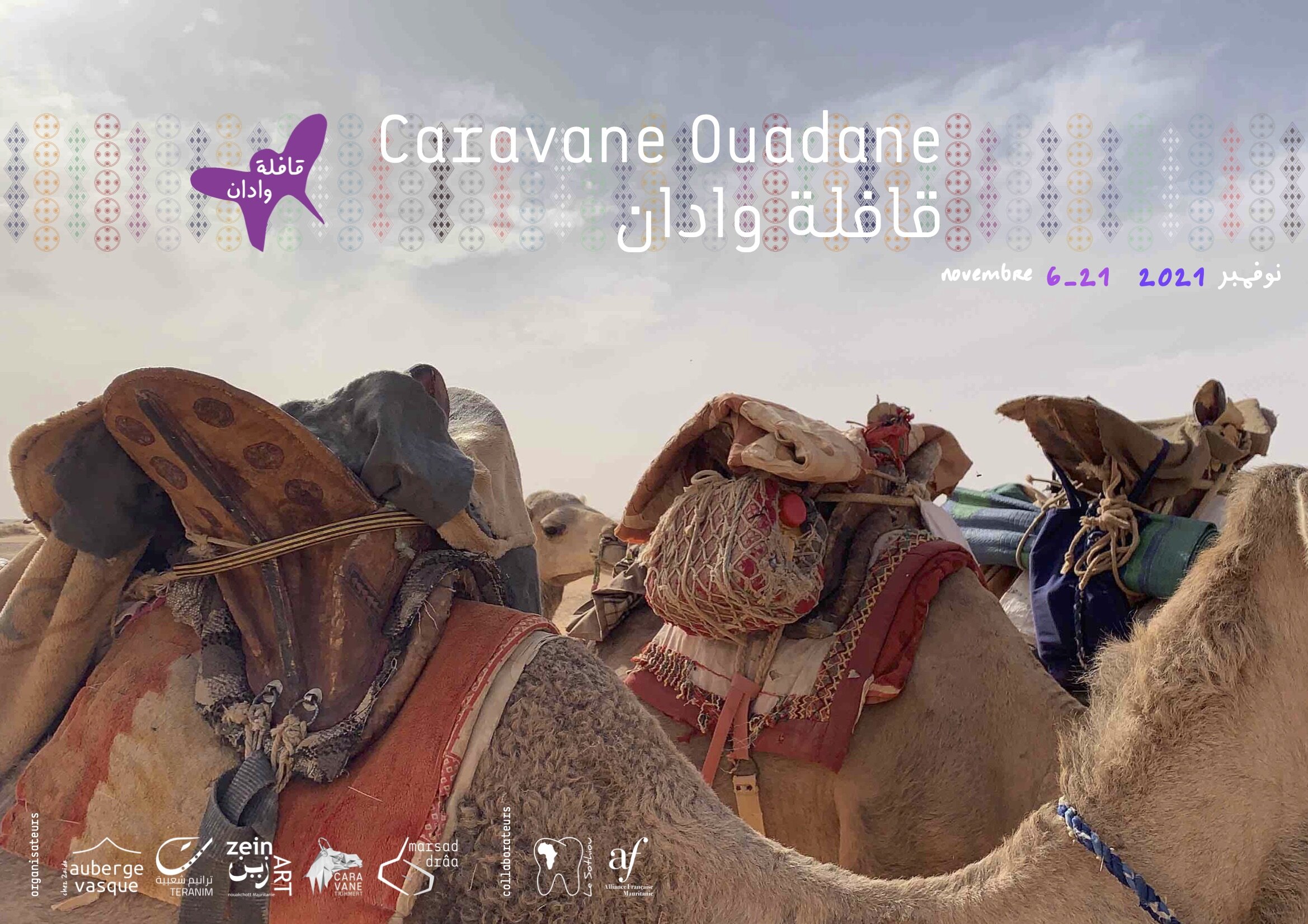
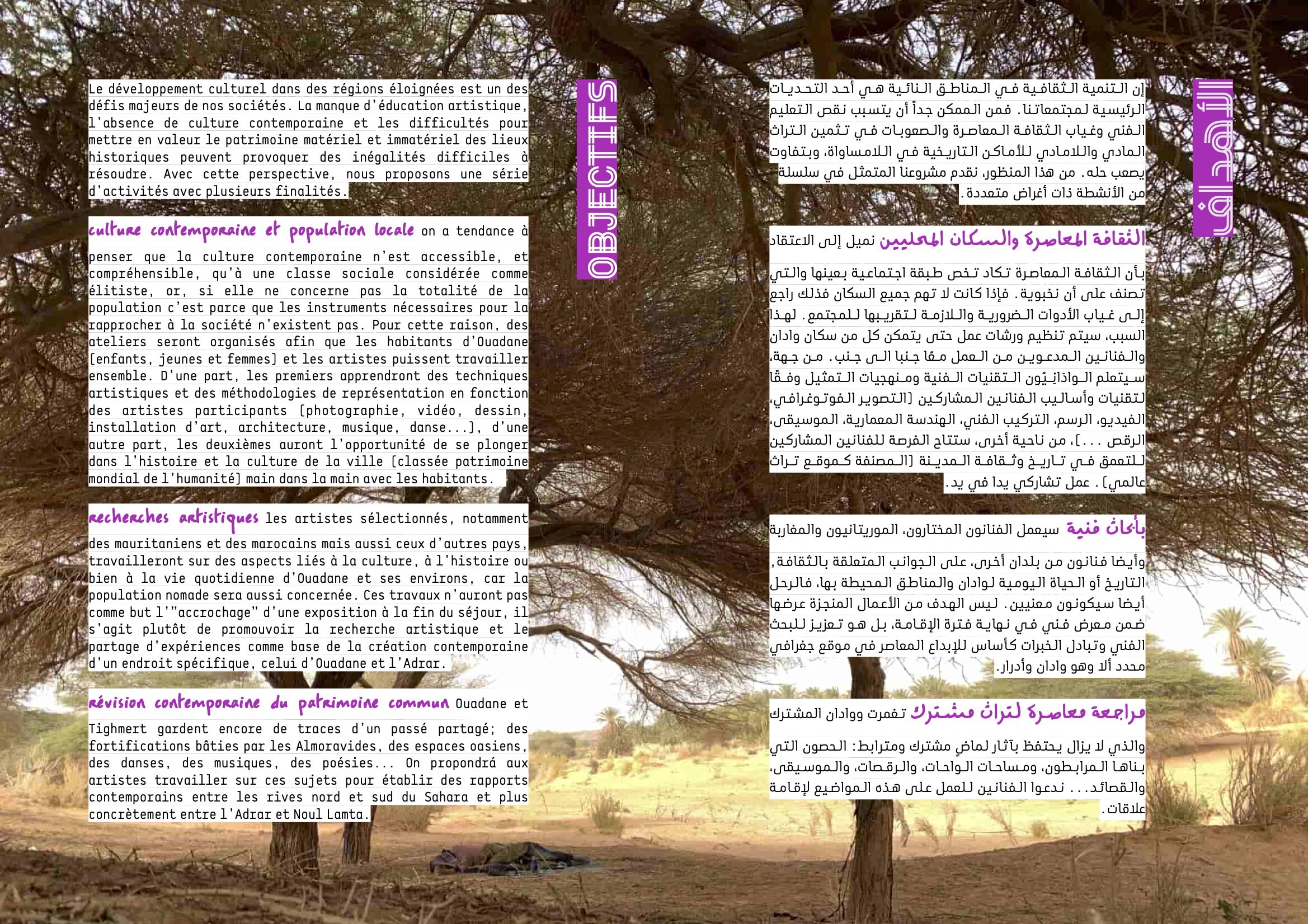

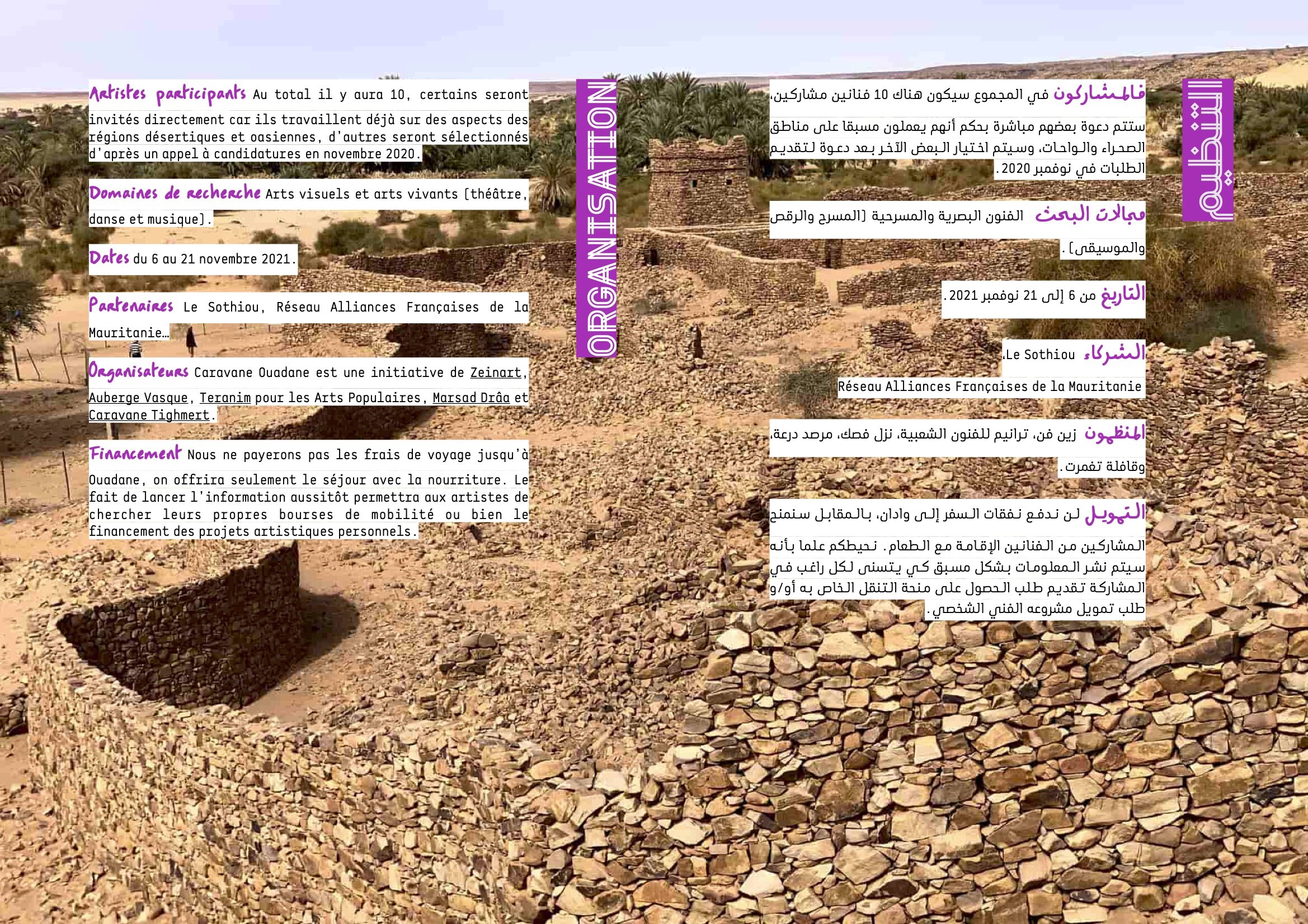
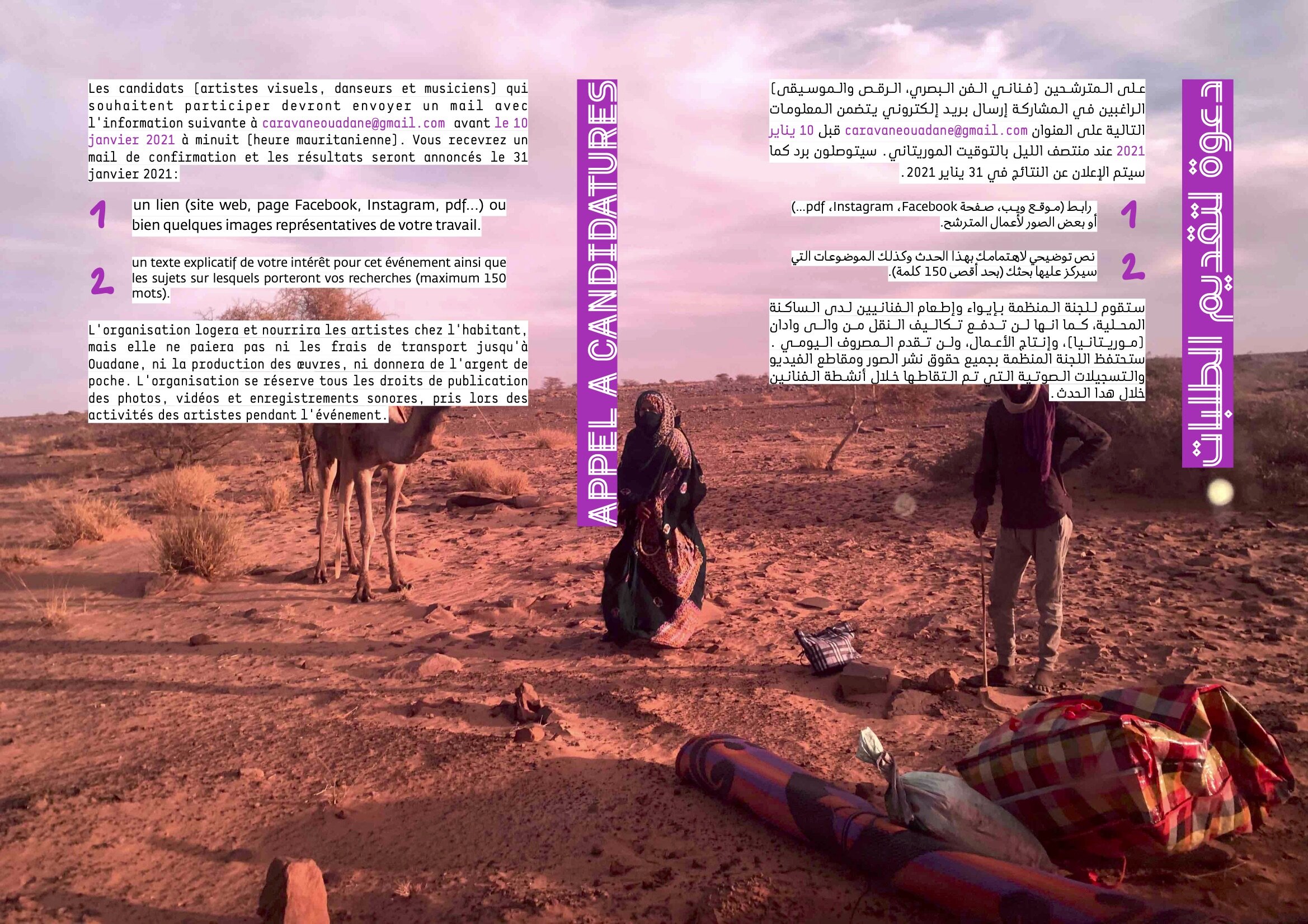
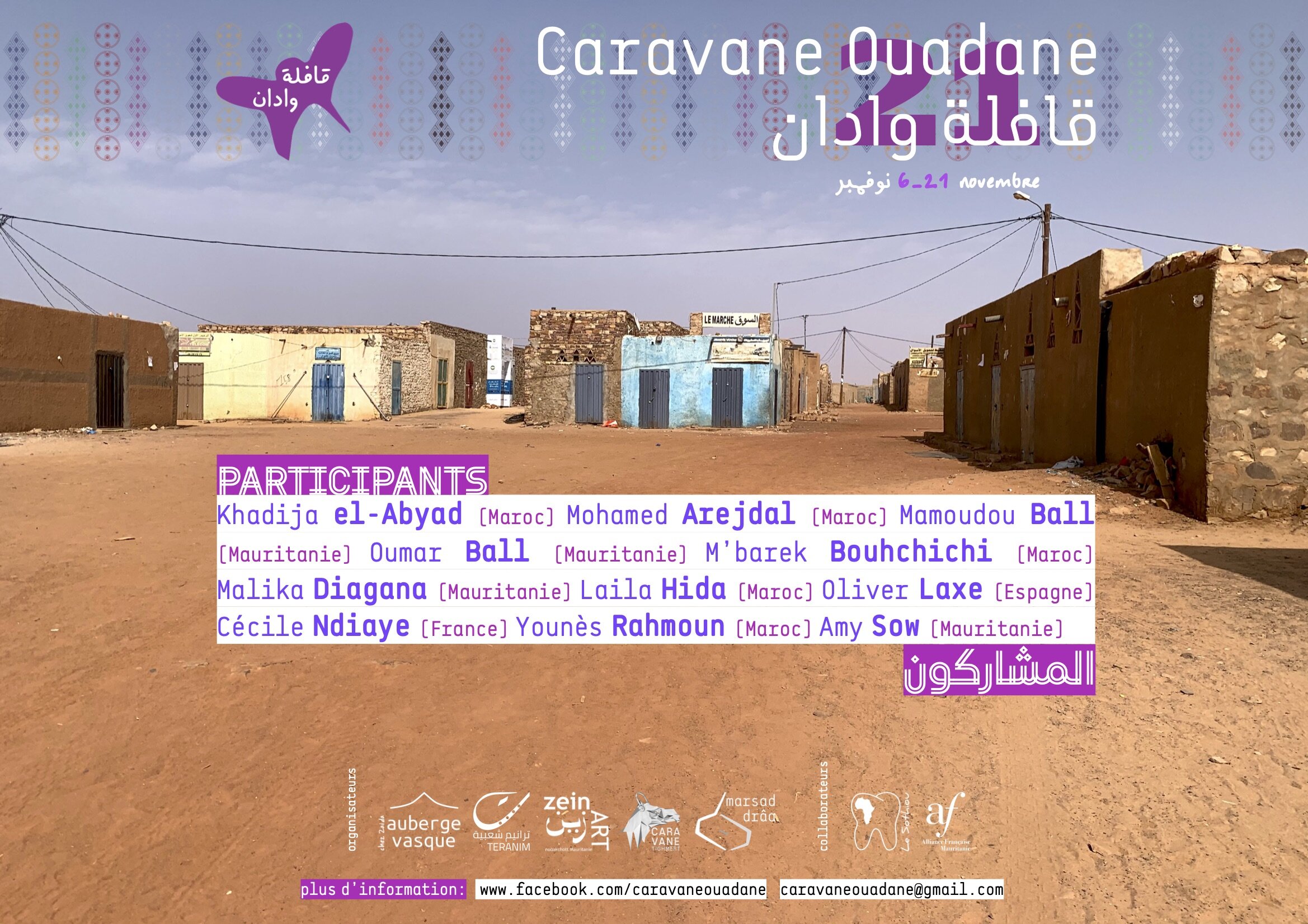
All the experience in the desert, through research and projects like Caravane Tighmert and Project Qafila, plus all these questions, will be essential when organising the first edition of Caravane Ouadane next November, because it will put us in a situation I (we) usually criticise, the behavior of European and Arab cultural institutions in Morocco. We risk wanting to develop a “Moroccan” cultural activity, by copying Caravane Tighmert to Ouadane. With Ahmed Dabah and Younès Rahmoun we had a conversation along these lines during our journey (Obûr) in Mauritania in January 2020, and quickly we saw that we had to develop this new “Mauritanian” proposal, considering the reality of local art and culture, in fact, if it weren't for the involvement of associations and people from Ouadane (Zaida Bilal from Auberge Vasque) and Nouakchott (Mohamed Ali Bilal from Teranim and Isabel Fiadeiro from Zeinart and also Teranim), we would never have made the proposal. For me, it's not about expanding a project like Caravane Tighmert and transposing it to Ouadane or exporting a cultural project to give us more value, which pushes me to organise this new event with my friends, it is the curiosity and the desire to know more about another desert region that I consider that it has the keys to understand a lot of subjects connected with the heritage and the culture of Morocco and my own city, Ceuta. It is obvious that there are elements and situations that are common to Ouadane, Tighmert, Marrakech and even Moulay Bouchta; the architectural heritage of the Almoravid dynasty; the caravan routes that connected these territories; the issue of arts education and access to contemporary culture in rural areas; the place of artists in these societies; the model of cultural development... I am pretty sure that Caravane Ouadane will give us new avenues to explore subsequently in Tighmert, Marrakech, Moulay Bouchta al-Khamar, even in the Strait of Gibraltar (where we are awaiting the opening borders to start an initiative called Chawati with friends from Tangier, Algeciras and Gibraltar).
I consider myself so privileged to be able to have, at the same time, a global vision and a local one of territories and cultures so distant but similar, that I feel obliged to share it with friends and with all those who are interested in these same questions, and it is through these “artistic” events that I found the best way to share them.
a non-strategy
We could say that Caravane Tighmert is part of an informal, unwritten, unscheduled program, variable according to needs and desires, where we do (and share) researches on the desert, and which takes place in parallel with the activities carried out within the framework of Marsad Drâa, Project Qafila, Caravane Ouadane, Qanat… by having several levels according to the degrees of difficulty when it comes to understanding (and apprehending) the complexity of the desert. I don't know if the desire to walk on the old caravan routes with the nomads is a consequence of Caravane Tighmert, probably it helped, but the desire to carry out this practical research started with the journeys to the Drâa valley with ENAT students (between 2010 and 2013), with the encounter with nomads in 2013 and with stays at Café Tissardmine (Errachidia). In any case, I was able to learn from each project and each event was nourished by the two initiatives, this is how we incorporated in Tighmert the subjects related to nomadism, including stays outside the oasis (in 2017 was one night, in 2021 three). This experience allows me to establish a classification, by observing the behavior and adaptability of the participants:
level 1 Caravane Tighmert, one participation
level 2 Caravane Tighmert, two participations
level 3 Qafila saghira, one week
level 4 Caravane Ouadane
level 5 Qafila kabira, two weeks, in Morocco
level 6 Qafila max, four weeks, in Mauritania
Each level requires physical and psychic training which increases gradually and which requires a lot of time for preparation, as well as the financial demands to achieve them which increase at each level. This poses problems for us because we are aware that not everyone has the money to do them (but we can see who is really interested), it is in these cases that we have to think about putting into practice the essence of belonging to a community and help those who cannot afford the fees but deserve it.
What is important to notice, it is that you cannot bring someone into a qafila without having gone through this physical and psychic process. After Qafila Oula in 2016, I was wrong when I suggested some friends to do Qafila Thania, thinking that coming to Tighmert was enough to know if one could "resist" the experience. For this reason, I did Qafila Thalitha alone (with Mouloud and Omar in the logistics), but in 2017 I have proposed to use Caravane Tighmert as a kind of initiation for those who want to deepen, subsequently, on topics related to caravans and nomadism. The second stage of this preparation gave rise to Qafila Rabiaa in 2019, a seven days hiking with journeys of 3 heures (instead of 5). The third will be Caravane Ouadane and I still have one challenge, to do qafila in Mauritania, following in the footsteps of Théodore Monod (without forgetting the two or three week routes to do again in Morocco).
The difference between a qafila in Morocco and one in Mauritania is present in the mapping of the territories to be crossed, simple representations, with very few geographical elements (and therefore references) which means more complexity but a closer approach to the essence of the desert.
the future
I have no idea what form Caravane Tighmert (and “parallel” projects) will take in the coming years, everything will depend on our desires to test new experiences, our curiosity to learn more and our ability to adapt the proposals to circumstances, in any case there are two final questions to think about which will be fundamental in deciding our path.
Although there are artists who return to the oasis to develop their projects initiated during Caravane Tighmert, we wondered how we could give continuity, during the rest of the year, to the activities and researches of these artists. It was a shame not to have been able to put in place the cultural strategy, NOUN, that we had made at the request of the authorities of the province in 2017, a project which would have been an opportunity to relaunch cultural development in Morocco, at least in rural areas, since it was a question of carrying out educational and artistic activities and researches on 15 oases of Guelmim, by working on several disciplines (visual arts, cinema, theater, music, contemporary dance…) and throughout the year. For the moment NOUN remains an utopia, but we will not stop presenting it to calls for culture projets in the region. In the meantime, we will manage, as usual, with our own (and limited) means, so we have discussed the possibility of using a plot (inside or outside the palm grove) as a transdisciplinary laboratory (art, architecture, agriculture, sociology…) and make it available to the Caravane Tighmert community, which continues to grow over time.
The other possibility, which is not exclusive, would be to go all the way in the quest for the essence of the desert. I very much appreciated Youssef Titou's comment in the epilogue during Qafila Rabiaa. To the question of what had marked him the most in this caravan, he said about Mokhtar, the nomad who accompanied us: They are very simple, minimalist, they don't complicate their lives, they take things lightly, I would like to get to that one day. It's a subject that has been going around my head for a long time and that I try to explain with texts (Dimensions of a desert, Dimensions of perceptions) and drawings.
drawing for the exhibition À l’Épreuve du Tamis, LE 18 MARRAKECH (February 2020)
We will see what we will do in the future and if in the end we cannot do what we would like, it will not be a problem, we will adapt ourselves, as usual, but at least we will enjoy every experience and if possible, with our friends.
Ceuta, April the 20th 2021
Carlos Perez Marin
Image credits: Carlos Perez Marin










